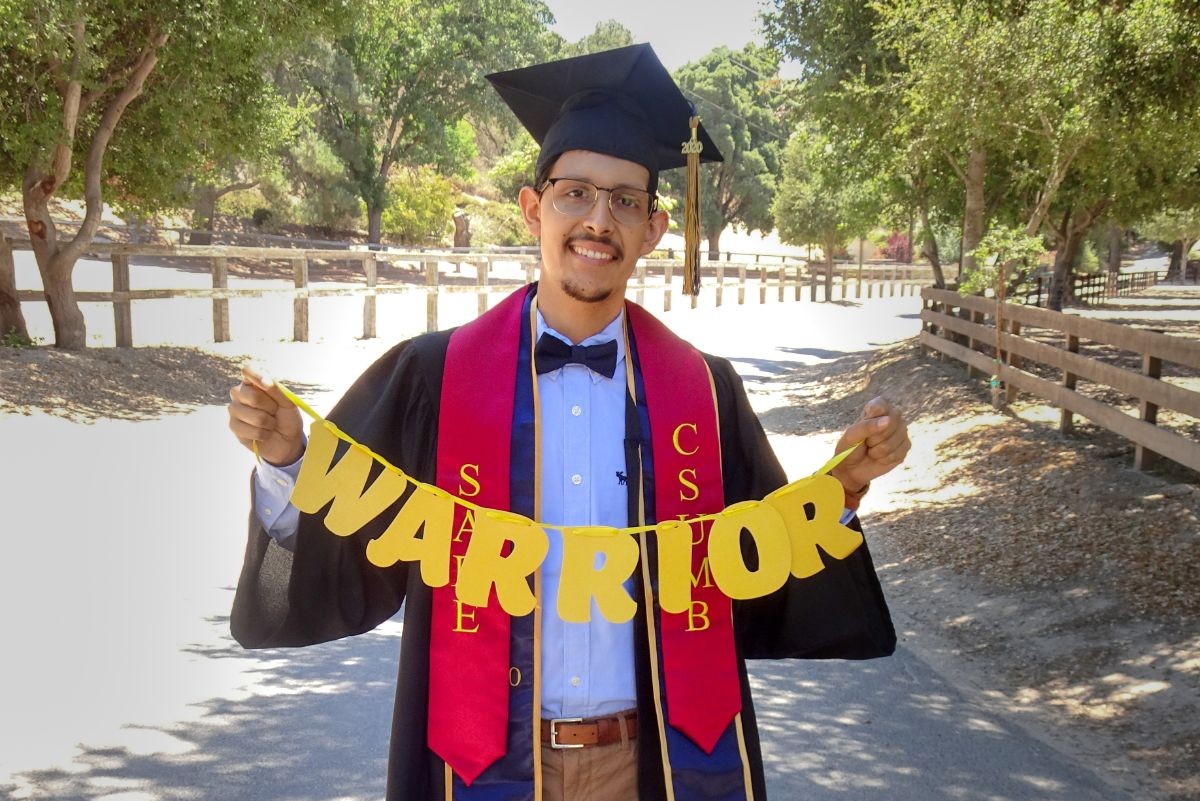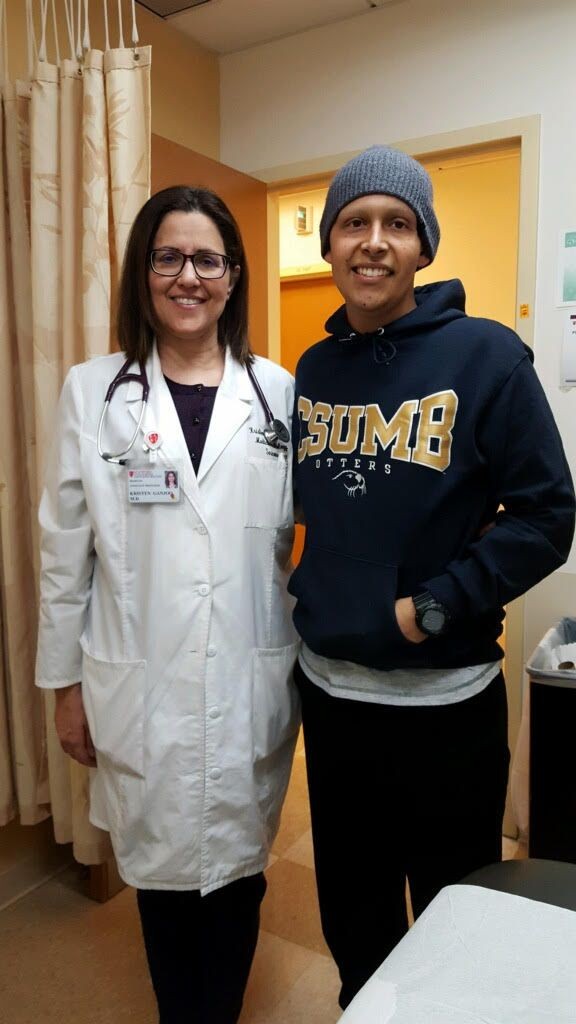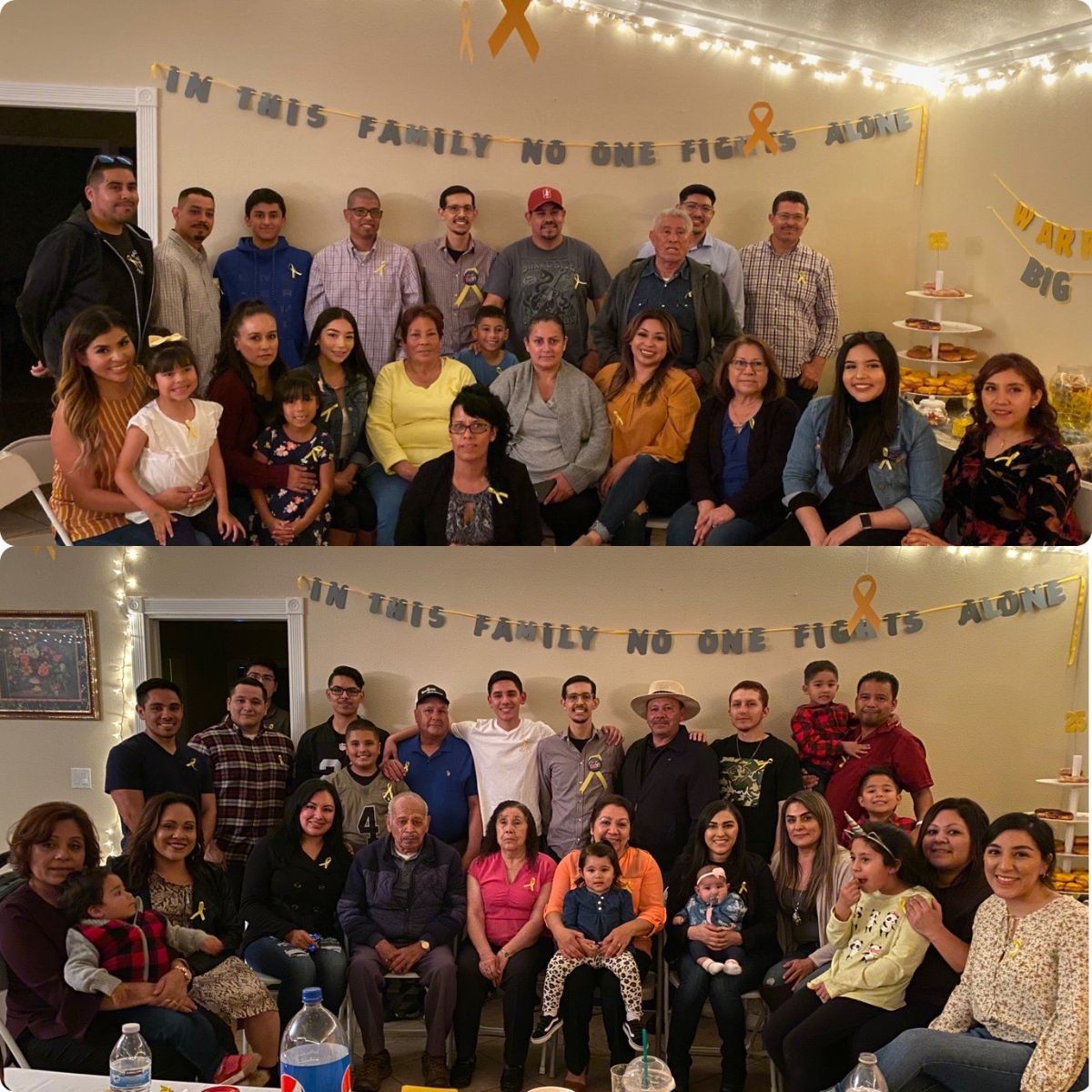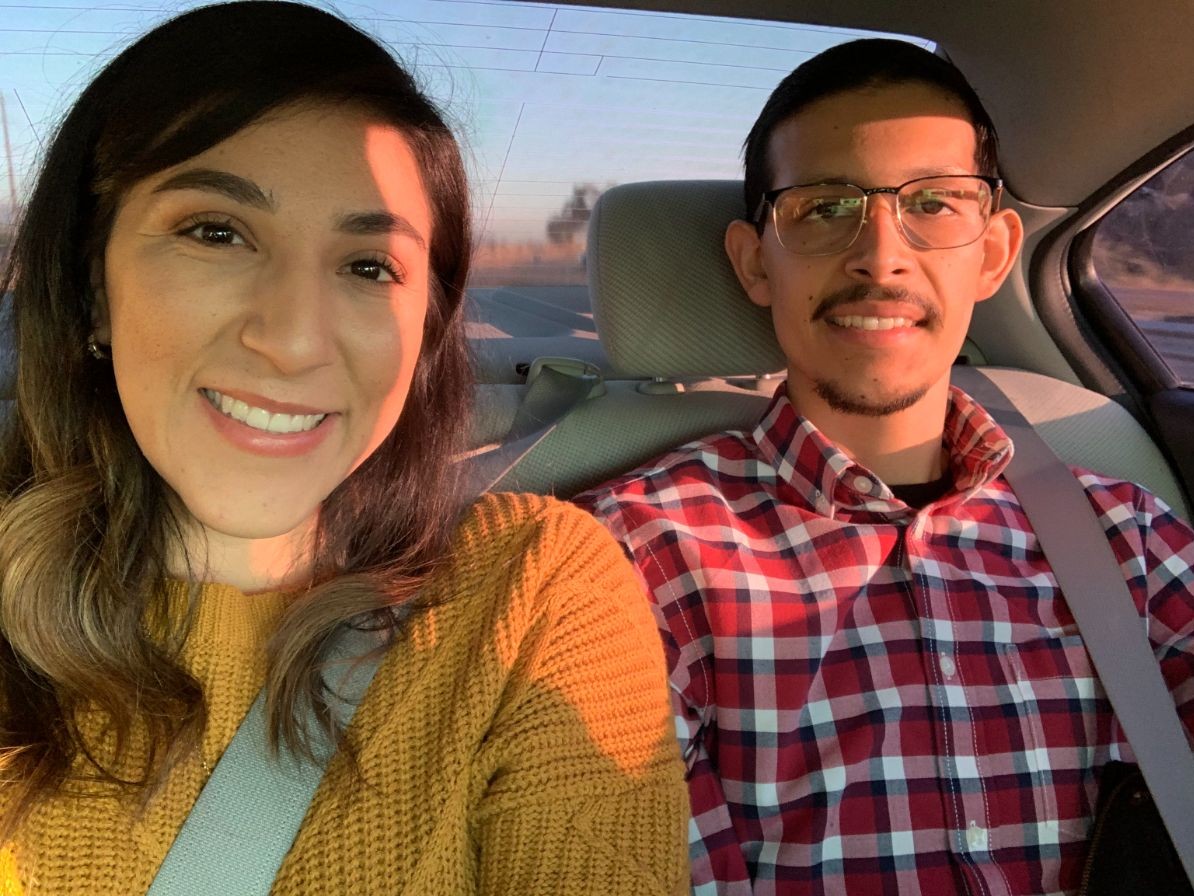Lessons from Martin

Photo by: Provided by Martin Cisneros Jr. Martin Cisneros Jr. in his graduation cap and gown
November 24, 2020
By Walter Ryce
Martin Cisneros, class of 2020, shares the story of his ongoing 10-year battle against cancer to inspire others.
Early Years
Martin Cisneros Jr. was one of CSUMB’s Spring 2020 graduates who had to forego a commemoration ceremony due to the coronavirus pandemic. But he’s accustomed to navigating obstacles.
Cisneros, who pronounces his first name as “mar-teen,” was born in Salinas. But when he was 10 his family moved to Greenfield where his dad’s job was, just as violence in Salinas was, he says, “starting to bubble up.”
Their roots are now in Greenfield, a small, sunny town of 17,000 people in the Salinas Valley between the Santa Lucia and Gabilan mountain ranges. The biggest building is the Rancho San Miguel grocery store, and if Cisneros encounters someone in town he probably knows them. For fun they would drive out to see a movie at the multiplex at Del Monte Shopping Center in Monterey.
When Cisneros was 16, the first sign of cancer appeared. A classmate at Greenfield High School told him his face looked “unbalanced.” Cisneros looked in a bathroom mirror but couldn’t discern any issues. Some months later he got a haircut which made a lump on the side of his face more noticeable. His parents saw it too.
They took him to an emergency clinic in Salinas. The physician there sent him to a head and neck specialist who ran a CT scan, told the family it was likely a tumor, and sent them to Stanford Hospital.
“At Stanford, we were there from eight in the morning to eight at night,” Cisneros said. “Multiple doctors came in, taking samples from the tumor with a needle, putting a camera up my nose to make sure the tumor wasn't near my nose or my mouth or tongue.”
They took an MRI. The results took a month to come in: the tumor was a rare malignant cancer called synovial sarcoma.
Surgery was scheduled for Aug. 2, 2011. The eight-hour procedure required an incision from the top of his forehead to the top of his left ear, and the large tumor, which had grown in the lining inside his cheek, was successfully removed.
Because of his youth, he recovered quickly from the surgery. Then he was referred to Lucile Packard Children's Hospital where an oncologist set up a six-month treatment plan of one week of chemotherapy every two weeks, and one month of radiation.
“It was hard,” Cisneros said. “One thing that helped me through is being hopeful, faithful, leaving it up to God. That’s helped me and my family.”
The last of that chemo cycle happened on New Year’s Eve 2011, after which Cisneros was deemed cancer-free.
In 2012, Cisneros was a senior at Greenfield High School when he met Vanessa Flores in one of his classes.
“I sat in front of him on our first day of school in math class,” she said. “I was a junior and he was a senior. It was love at first sight for me.”
He found her to be generous and kind, and they started chatting through Facebook. They went out on a date where he told her about himself, what he was going through.
“She accepted me,” he said. “After the head surgery, it kind of left a dent because they had to remove a nerve with the tumor. They took one of those nerves and put it on my eyebrow so I could move my eyebrow up and down. The radiation left some of the hair out. She accepted me anyway.”
They both enrolled at Hartnell College to pursue their dreams together.
That blissful period of time didn’t last long.
In 2015, during monitoring, Cisneros’ doctor found “little spots” on his lungs; the cancer had relapsed there. He would have to do the treatment regimen all over again.
“I had no clue how to handle the news,” Flores said. “He reassured me he would be fine and expressed how I was his motivation to fight his cancer.”
Next came a series of surgeries and biopsies, immunotherapies, chemotherapies and cryoblations (when they freeze tumors with a needle). He persevered through it, finishing Hartnell College after three years before transferring to CSUMB in 2017.
Student Life
Cisneros loves graphic design and chose CSUMB for its Bachelor of Science degree in Communication Design. Flores joined him there with the plan to graduate together. Its location was ideal because it was close to Palo Alto where his treatments were taking place.
“He had many ER visits, pain, nausea and discomfort, and still went to class the next day,” Flores said. “There were days where he was so weak and so out of breath from doing simple tasks like making his bed. This guy has so much fight in him.”

Photo by: Provided by Martin Cisneros Jr. Martin at age 23 with his oncologist Dr. Kristen Nooshin Ganjoo in 2018.
Before the pandemic, when the campus contracted to have electric scooters for use, if Cisneros didn’t think he would make it walking across campus, he would ride a scooter.
The Student Disability and Accessibility Center (SDAC) office told him that they could help him in his pursuit of a degree. They have services for students with temporary or permanent barriers related to disability or medical conditions, whether physical, learning or psychological. In Cisneros' case, they could provide letters of accommodation that would allow more time to turn in assignments or to take tests on alternate days when his medical needs required it.
At first he didn’t want them.
“I always wanted to feel like I didn’t have [an illness],” he said. “I wanted to have the student life without…the extra support. There was a time I wanted to forget about it, be like a normal student—not that there’s a normal student. That’s when I started getting worse. I had to accept that this cancer was a part of me.”
Sometimes he had no choice. In 2017 he missed the last portion of the semester due to emergency chemo sessions for a lot of arm pain.
“I remember it was November because we spent Thanksgiving at the hospital.”
He couldn’t stay up late doing homework or studying as other students could. He had to get lots of sleep and nutrients to keep his immune system strong and stay out of the emergency room.
There is a lot of nerve pain with his cancer, especially his left arm, side, back and chest. If it’s really bad he takes a nerve pain medication or oxycodone, which he tries to avoid. He’s tried CBD capsules in the past for insomnia and appetite, but they got too expensive.
If Cisneros knew he had medical appointments coming up, he would turn in class assignments early in order to use the disability accommodations sparingly. But he appreciated that Student Disability and Accessibility Center (SDAC) helped a lot, in particular Annamarie Dominno-Cailles, a disability resources advisor.
“She made me feel comfortable with going to school and not feeling so overwhelmed,” Cisneros said.
Regardless of what he was going through, just knowing that he had the support of the school, classroom buddies and faculty relieved him of undue stress.
Kevin Cahill, associate professor in the School of Computing and Design, said that Cisneros’ capstone project was a series of six posters he designed for the Monterey County Rape Crisis Center’s (MCRCC) annual Together with Love race held in Pacific Grove.
“The posters beautifully explained to guests of the race the range of services the Center provides as well as how the users benefit from these contributions,” Cahill said. “As a board member for MCRCC, I really enjoyed working with Martin on his capstone and was very impressed with his results.”
Bobbi Long, also an associate professor in the School of Computing and Design, said she was honored to have Cisneros as a student.
“He inspired me every semester for three years and still does,” Long said. “Despite absences from illness, Martin not only completed his assignments on time, but also raised the bar for the rest of the class. We were lucky to have him as a student.”
Vanessa Flores has been an invaluable partner to him for seven years now.
“Words can’t explain how grateful I am to have had her there,” he said. “There were times I couldn’t drive myself, and we would carpool. If I felt like I needed to come back home, she would bring me. There were times when I felt like I didn’t want to continue school sometimes. She helped me reach out to instructors because I was too tired.”
That fatigue also dampened his involvement in sports activities (he’s a big 49ers fan) and extracurricular clubs. But ironically, his health issues prepared him for coronavirus pandemic measures.
Even before the arrival of coronavirus, he wore a face mask in order to protect his lungs from foggy days or from catching a cold or flu. He washed his hands frequently, his family stocks hand sanitizer in the home, his mom disinfects the house three times a month, they’ve kept sick relatives at bay, and Cisneros would quarantine sometimes.
His family has had these measures in place since his first diagnosis in 2011.

Martin (center) and Vanessa (bottom right) among family
Though his student experience has been curtailed, Cisneros has relished the simpler joys of being at CSUMB.
“I liked just being able to walk on campus,” he said. “Vanessa and I went to the cafeteria a couple of times. It was really cool. Just walking, breathing, feeling that experience of being a student.”
Here and Now
His brother and father are the only people in his household who work. His father’s insurance, through his job, has helped cover the costs of Cisneros’ treatments. People close to the family have helped in their own way, but there is no concerted or ongoing fundraising campaign for the family.
Flores had two jobs, but her own grandfather got diagnosed with cancer a year ago, and she quit working in order to take him to his appointments, to be available to him and Cisneros, and to reduce both their exposure to coronavirus.
“He’s doing way better now,” Cisneros adds.
Since graduation, Cisneros has been trying to enhance his graphic design skills on his own. He’s done a few side jobs here and there, like for a local candy shop or for friends. He designed an anti-cancer logo. In his free time he plays video games, drives around town, or tries to get exercise if it’s not too hot or cold out.
He’s doing chemotherapy now, once every four weeks. He goes in to “get connected,” brings the pump home in a little black bag, and connects it to a catheter inserted in his arm. Then he goes back 24 hours later to get disconnected, and they give him an injection in his stomach that releases white blood cells over a period of 27 hours to help him recover from the chemo. It takes longer to recover now that he’s 26 than it did when he was 16.
His doctors are trying to make sure he’s stable, and his goal is to be cancer-free and get the catheter out of his arm. Flores is studying for her master’s degree in counseling psychology with an emphasis in marriage and family therapy. They see each other when they can as both families are cautious about quarantining, and they attend couples therapy as a prerequisite for her degree.

Vanessa and Martin
“Vanessa is my other half,” Cisneros said. “She’s proven to me that she’s not just there for the good, but the bad times. No matter what. That’s something hard to find in this world. She’s helped me to look forward to the future.”
Cisneros and Flores had planned to walk commencement together at CSUMB. She graduated in spring 2019 with a B.A. in Psychology. But because of his medical issues, Cisneros graduated a two semesters after his girlfriend.
“Unfortunately, COVID-19 did not let Martin celebrate commencement traditionally on stage, but you bet I would have been in the stands cheering my heart out for him,” Flores said. “I have never prayed for someone so hard and so much in my life as I have for Martin.”
He was the first in his family to graduate college.
“I know graduation is a milestone and it’s something I will cherish forever,” he said. “Anything is possible if you put your mind to it. It’s not easy. At all. Just have hope. You can get through it.”
Martin Cisneros’ website is martincisnerosjr.com.